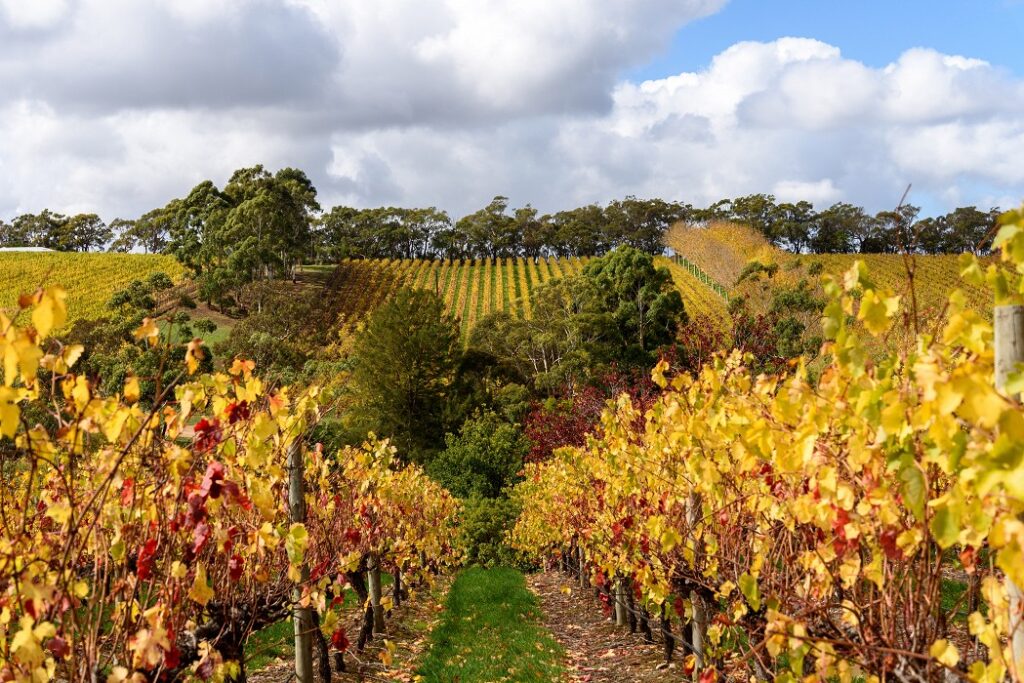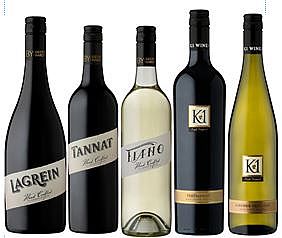By Nicki Bourlioufas
Only a 20-minute drive from Adelaide, the Adelaide Hills offers a great wine-tasting experience and an exceptionally pretty place to visit with rolling hills, fruit orchards, steep gullies and grapevines. It is the closest of the South Australian wine regions to the Adelaide CBD and for my money, the prettiest.
Touching the Barossa Valley to the north and McLaren Vale to the south, the region can be accessed from many directions. If you want, you could visit the McLaren Value in the morning and Adelaide Hills in the afternoon, then head back to the city for dinner, so close are these wine regions.
And the wine-tasting is great! But a warning – take a jumper. You tend to hear ‘cool climate’ a bit too much in Australian winemaking. But it really is cold here, especially at night, but also in the day. I visited on a day in the 2020 summer in January and it was just 12C during the day!
Many Adelaide Hill wineries produce Pinot Noir, Sauvignon Blanc and Chardonnay – the original Adelaide Hills grapes of choice. But since then, much has changed and more varietals have been introduced, including Tempranillo (from Spain), Arneis (from Italy) and Gruner Vetliner (from Austria).


David LeMire MW, joint CEO of a pioneer winery in the region, Shaw + Smith, says the Adelaide Hills climate is cool, with cold nights, often up to 10°C cooler than Adelaide while the days are also cooler, usually by 3 to 4 °C.
“The altitude is a key factor, and the range of different facing aspects is also important to the diversity of the Adelaide Hills. A south or east facing vineyard can be notably cooler than a north or westerly facing slope,” says LeMire.
“As a result of these factors, our styles tend to be quite elegant, and aromatic, rather than big and heavy.” Visitors to the cellar door can book a wine flight tasting here.
Hahndorf Hill winemaker Larry Jacobs says although close to the Barossa and McLaren Vale, the Adelaide Hills has a well-established cool-climate profile, which the other regions do not.
“We are cool climate, not because we have particularly cool days in the summer growing season, but because we have very cold nights in the summer growing season.” He says the January minimum temperature at night can fall to as low as 3.5C to 6C degrees on several days during that month.
“So, it is by virtue of our very cold nights that we have a low average or Mean January Temperature (MJT). In fact, over the past few years that I’ve been monitoring the MJT, we have had an average of between 18.5 – 19.5 C as our mean January daily temperature – by virtue of our cold nights,” says Jacobs.
That combination of warm summer days and cool nights, and a huge variation in soil types in the region, allows winemakers to grow a broad range of so-called alternative varieties as well as traditional French grapes such as Pinot Noir and Chardonnay. Hahndorf Hill offers various seated tasting experiences at its cellar door – see its menu here.
Rainfall too is higher, and in parts of the hills it is two to three times the rainfall of McLaren Vale, less than 30 kilometres away and closer to the sea. This is a bonus given that Adelaide Hills is located in South Australia, the driest state of any state or territory in Australia. For that reason, it produces some of the best wines of the nation.
According to Geoff Hardy of Wines by Geoff Hardy, the Adelaide Hills experiences weather more in line with Bordeaux and the northern Rhone in France and grapes ripen about three weeks later than in the nearby McLaren Vale or Barossa Valley.


“This climate along with unique terroir stemming from ancient podsolic soils produce wines of very high quality,” says Hardy, who produces the premium K1 range single estate wines from the K1 Vineyard he planted in 1986, called K1 as it’s the first vineyard in the Kuitpo region. His other brand, Wines by Geoff Hardy, has been trialling many less common European varieties and many clones of the more traditional varieties over the last 20 years or so. In addition to Lagrein, Grüner Veltliner, Tempranillo, Montepulciano, Nero d’Avola and Tzimmukin, Hardy has also planted Arneis, Fiano, Gewurztraminer, Viognier, Teroldego, Tannat, and Durif.
After joining his family’s famous wine business Thomas Hardy & Sons in 1975, and having worked all over the world, Hardy launched the Hand Crafted by Geoff Hardy and GMH ranges of wine in 2004. Together with K1 Wines, these brands now make up Wines by Geoff Hardy. The beautifully situated K1 cellar door overlooks a lake and vineyards and visitors can book a tasting online here.
Managing climate risk
But there are warnings that global warming could harm grape production in the Hills region and erode the cool climate and the branding that brings. Devastating bushfires earlier in 2020 in the Adelaide Hills highlight that risk of devastating heat and climate events.
“Global warming is a significant issue for us in cool climates. We grow grape varieties like Pinot Noir and Chardonnay that are really sensitive to the environment, and it can have a big impact on the style and quality, and even the viability of some sites,” says Shaw + Smith’s LeMire.
“If it becomes too warm, the vines and wines will be less well balanced, the vineyards might need more irrigation, the aromatics may be impacted, the ability to ripen phenolics and achieve a balance of acid and fruit will all be compromised,” he says. The risks are managed through canopy management to give more shade, soil health to retain moisture, irrigation and earlier harvesting, says LeMire. But longer term, new grape varieties which ripen later might need to be planted In the region to offset a warmer climate.
Shaw + Smith’s Sauvignon Blanc has become a benchmark for the cool climate Adelaide Hills region and Australian Sauvignon Blanc, with its finesse and more restrained fruit flavours than a New Zealand peer. Low yields and hand harvesting add to its character. Another Adelaide Hills benchmark is the 2020 Shaw + Smith M3 Chardonnay. The 2019 Shaw + Smith Shiraz rounds out the new releases, with the cooler climate of the hills giving this wine spice and plum. Visitors can book a wine tasting here.


If it’s a Pinot Noir tasting you’re after, I enjoyed Ashton Hills winery and Brian Croser’s Tapanappa. Ashton Hills is a three-hectare, dry-grown vineyard that lies in the Piccadilly Valley sub-region of the Adelaide Hills on a ridge just below the summit of Mount Lofty. The estate was founded by Stephen George in 1982 and since that time it has built a solid reputation as a pinot noir producer. Its Piccadilly Valley location is the coldest and wettest sub-region of the Adelaide Hills. The small winery is charming and well worth a visit, with its stunning views.
Tapanappa is a wine tasting delight with a very large and elegant cellar door surrounded by vineyards. It is Brian Croser’s family-owned winery in the Piccadilly Valley where it began more than 40 years ago as Petaluma. While Petaluma was taken over by Lion Nathan in 2001, the Crosers retained ownership of their family home and the Tiers Chardonnay vineyard at the foundation winery site. The next year, Brian and Ann Croser established Tapanappa. Today, Tapanappa remains in family hands. Bookings for seated wine tastings can be made online here.
Alternatives abound
The Adelaide Hills is also home to many emerging grape varieties. An emerging popular wine from the Adelaide Hills is Grüner Veltliner. Most Australian plantings of this Austrian grape are in the Adelaide Hills, where it grows very well due to the cooler climate and higher altitude than South Australia’s other more famous wine regions – the Clare Valley, McLaren Vale, the Barossa Valley and the Coonawarra. The Australian benchmark is produced by Hahndorf Hills Winery, owned by Marc Dobson and Larry Jacobs, who have pioneered Austrian grape varieties including Blaufrankisch, Gruner Veltliner, Zweigelt and St Laurent in Australia. Their Gruner wines have won many local and international medals, including the devine Hahndorf Hill Reserve Gruner Veltliner 2019, my personal favourite, and the Gru Gruner Veltliner 2021.


Bird in Hand also produces a selection of Italian varietals, including a 2018 Bird in Hand Nero d’Avola and 2021 Bird in Hand Pinot Grigio. The winery is one of South Australia’s first major venues to bring in a “no jab, no entry” rule for patrons. Bird in Hand winery announced the COVID-19 vaccine will be mandatory for staff and customers from November 15, with other big businesses expected to follow. In a post to their social media pages, Bird in Hand said: “A double dose of the vaccination will be required on entry”. The popular cellar door and its restaurants are currently closed for renovation. Other winemakers in the region support this move, but will wait for the government to regulate any such mandates.
“Regarding the possible requirement for full vaccination prior to visiting a cellar door, we plan to wait for official government guidance on this issue,” says Hahndorf Hill’s Jacobs.
